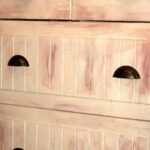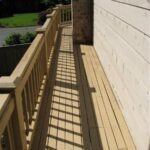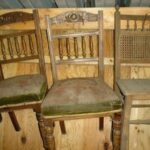Refinishing is the process of stripping a surface of its current finish and replacing it with a new one. Refinishing a dresser can restore its beauty, increase its value and just give it a new look. You can use this process to save money buying yard sale or discounted furniture due to aging and damage, or even to restore antiques for a collection or to sell for a profit.
Refinishing is often one of the steps involved in restoring a piece of furniture. Restoration also includes repair and replacement of hardware. Though refinishing can be done to any material a dresser is made out of, wood is the most common building material found in dressers. This guide on how to refinish a dresser will then cover only the process of stripping paint from a wooden dresser and then applying a new finish.
Keep in mind that the process of refinishing a dresser while fairly simple skill wise is time intensive. It is best not to begin a project until you have a few days of free time on your hands. Also, remember that the dresser will need to be empty during the refinishing project, so if you are currently using the dresser expect to have to locate a place to keep misplaced items.
The first step in refinishing a dresser is to begin removing the old finish. In most cases, this requires paint removal. If your dresser is only stained, go ahead and move to step two of this guide, sanding.
Remove all items from the dresser and move it to a well-ventilated and easily cleaned area. This process can be messy. If you choose to work outdoors remember that rain can ruin your work. Have a near by and easily accessible way to cover the dresser.
You will need:
-Goggles and gloves
-Paint and Varnish remover
-Paint brushes
-Scrub pad such as grey or maroon Scotchbright
-Coffee cans or empty paint buckets
-A scrapper
-A bristle brush
-Kitty litter
Begin by pouring off some of the paint or varnish remover into a coffee can or other wide-open mouthed but re-sealable container. Then use your paintbrush to apply a thick coat of the stripper. For large areas, it is easiest to pour a glob in the center and simply spread it around. Allow to sit as instructed on packaging. Chances are your surface will now appear wrinkled and bubbled.
Use your paint scrapper to scrap away the paint layer. On areas that are not flat use your scrub pad or bristle brush. If any paint residue remains, you can use a small amount of paint thinner and a scrub pad to remove the rest. Collect your removed paint layers and mix them into the kitty litter. Allow to sit in a dry well ventilated area. The kitty litter will absorb the chemicals and make your messy easier to dispose of. Ask your local waste control how to dispose of it.
Once all the old finish is removed from your dresser, the next step is to sand. Sanding restores the surface of the wood giving an even finish as well as opens the grain of the wood so it accepts its new finish better.
You will need:
-100-120 grit sand paper
-Preferably a hand sander
Though you can hand sand a dresser his process is tiring and lengthy. An orbital hand sander will save your arm and a lot of time. To sand using even pressure sand the open areas of the dresser with the grain of the wood in even strokes until the desired finish. In harder to reach delicate areas hand sand to match the other areas you have already done.
While you can use one single grit of sand paper, some experts recommend using three and stepping up slowly to get a smoother result. For example, sand first with 80 grit, followed by 120 grit and finally finish with 180 grit. Some experts also feel different wood requires different grits of sand paper. You may research this for your particular wood type online or at your local hardware store.
The final step in refinishing a dresser is the new finish. If you like the color and appearance of the bare wood, you can simply apply a clear coat and call it good.
A clear coat is also called polyurethane. It is simply painted on like paint and allowed to dry. Some finishes require more than one coat. Follow the directions of your particular clear coat.
If you would like to change the color of the wood, you can either paint it and apply a clear coat or stain it. When working with stain it is a good idea to get a sample chunk of wood of the same type as your dresser and do some color test sections. It took you a lot of work to get your dresser to its bare wood it would be unfortunate to stain it and find you dislike the end result.
You will need:
-Old clothing
-A staining brush
-Stain
The actual process of staining varies by product. Follow the instructions on your chosen stain carefully and be sure to do so in a well-ventilated area. Outdoors is ideal if it is a sunny day. After staining, you may want to apply a clear coat to make your wood shiny.
You may also enjoy:
How to Paint Cabinets
How to Paint Concrete
How to Paint Stucco





